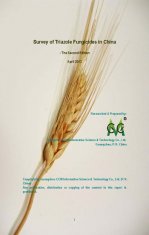Survey of Triazole Fungicides in China

China is currently the largest titanium dioxide supplier in the world, with its capacity exceeding the US in 2008 stimulated by growing domestic demand. Apart from the rapid capacity expansion, Chinese titanium dioxide industry is experiencing the following changes in currently sluggish market.
Raw materials' price decline Raw materials prices have slumped in 2009. For instance, sulfuric acid price has dived to USD58/t in Mar. 2009 from USD219/t in Jul. 2008. Will it stimulate China's TiO2 production and increase manufacturers' profits? What measures are Chinese manufacturers taking to enlarge profit margin?
Development of chloride process Pangang Group Jinzhou Titanium Industry Co., Ltd., the only Chinese producer adopting chloride process till now, has completed its chloride process capacity expansion in Mar. 2009, and aims to further expand in the future. What's the development trend of China's chloride process in the following years? And why there hasn’t been any foreign manufacturer investing in chloride process in China till now, by joint venture or singe proprietorship? Will DuPont establish its new plant smoothly in the near future?
Tightening titanium ore supply Vietnam, one of the most important origins of China's titanium ore, once declared to ban ore export in Jan. 2009. Facing high import dependence rate, how will Chinese producers ensure the sufficient raw material supply in the future?
Rising waste treatment cost In titanium dioxide industry, waste treatment cost constitutes relatively large portion of production cost. With the government's increasing attention to environmental protection, how will Chinese manufacturers deal with the rising cost?
TiO2 consumption change Though greatly impacted by the financial crisis, China's TiO2 demand broke a new record in 2008. However, Chinese end users have different consumption habits and usually replace TiO2 by other substitutes. What are the consumption habits and quality requirements of Chinese end users? Will the vitalising plans and other supporting measures benefit TiO2 industry?
This report describes the current dynamics of China's titanium dioxide industry, covering production and consumption, import/export analysis and benchmarking of key manufacturers. Based on the in-depth analysis, the report provide insightful qualitative and quantitative forecast to the next five years, and discloses the key opportunities for foreign suppliers and manufacturers aiming at Chinese and global TiO2 market.
In addition to the above issues, you can find detailed analysis for the following questions:
1. What are the capacity/output of China's top 30 manufacturers in Mar. 2009, and their product types, ore supply and inventories?
2. What are the characteristics of capacity distribution and concentration in China?
3. What's the profit situation and competitive advantages of benchmarking manufacturers?
4. What's the influence of highlighted cases, including amortisation, DuPont's entry, ore reserve policies and waste treatment standard, on titanium dioxide industry?
Introduction and scope of study
Methodology and source
1 INTRODUCTION TO TRIAZOLE FUNGICIDES IN CHINA
1.1 Development history of triazole fungicides
1.2 Position in Chinese fungicide industry
1.3 Governmental policies related to triazole fungicide industry
2 SUPPLY & DEMAND OF TRIAZOLE FUNGICIDES
2.1 Supply & demand summary, 2010-2013
2.1.1 Supply summary
2.1.1.1 Production summary (capacity & output)
2.1.1.2 Key manufacturers
2.1.2 Demand summary
2.1.2.1 Consumption volume & market value
2.1.2.2 Consumption by crops
2.2 Supply & demand of main products
2.2.1 Triadimefon
2.2.1.1 Production technology
2.2.1.2 Registration
2.2.1.3 Production, 2010-2013
2.2.1.4 Export, 2010-2013
2.2.1.5 Price, 2010-2013
2.2.1.6 Consumption, 2010-2013
2.2.1.7 Outlook, 2014-2018
2.2.2 Triadimenol
2.2.2.1 Production technology
2.2.2.2 Registration
2.2.2.3 Production, 2010-2013
2.2.2.4 Export, 2010-2013
2.2.2.5 Price, 2010-2013
2.2.2.6 Consumption, 2010-2013
2.2.2.7 Outlook, 2014-2018
2.2.3 Tebuconazole
2.2.3.1 Production technology
2.2.3.2 Registration
2.2.3.3 Production, 2010-2013
2.2.3.4 Export, 2010-2013
2.2.3.5 Price, 2010-2013
2.2.3.6 Consumption, 2010-2013
2.2.3.7 Outlook, 2014-2018
2.2.4 Flutriafol
2.2.4.1 Production technology
2.2.4.2 Registration
2.2.4.3 Production, 2010-2013
2.2.4.4 Export, 2010-2013
2.2.4.5 Price, 2010-2013
2.2.4.6 Consumption, 2010-2013
2.2.4.7 Outlook, 2014-2018
2.2.5 Propiconazole
2.2.5.1 Production technology
2.2.5.2 Registration
2.2.5.3 Production, 2010-2013
2.2.5.4 Export, 2010-2013
2.2.5.5 Price, 2010-2013
2.2.5.6 Consumption, 2010-2013
2.2.5.7 Outlook, 2014-2018
2.2.6 Difenoconazole
2.2.6.1 Production technology
2.2.6.2 Registration
2.2.6.3 Production, 2010-2013
2.2.6.4 Export, 2010-2013
2.2.6.5 Price, 2010-2013
2.2.6.6 Consumption, 2010-2013
2.2.6.7 Outlook, 2014-2018
2.2.7 Diniconazole
2.2.7.1 Production technology
2.2.7.2 Registration
2.2.7.3 Production, 2010-2013
2.2.7.4 Export, 2010-2013
2.2.7.5 Price, 2010-2013
2.2.7.6 Consumption, 2010-2013
2.2.7.7 Outlook, 2014-2018
2.2.8 Myclobutanil
2.2.8.1 Production technology
2.2.8.2 Registration
2.2.8.3 Production, 2010-2013
2.2.8.4 Export, 2010-2013
2.2.8.5 Price, 2010-2013
2.2.8.6 Consumption, 2010-2013
2.2.8.7 Outlook, 2014-2018
2.2.9 Epoxiconazole
2.2.9.1 Production technology
2.2.9.2 Registration
2.2.9.3 Production, 2010-2013
2.2.9.4 Export, 2010-2013
2.2.9.5 Price, 2010-2013
2.2.9.6 Consumption, 2010-2013
2.2.9.7 Outlook, 2014-2018
2.2.10 Flusilazole
2.2.10.1 Production technology
2.2.10.2 Registration
2.2.10.3 Production, 2010-2013
2.2.10.4 Export, 2010-2013
2.2.10.5 Price, 2010-2013
2.2.10.6 Consumption, 2010-2013
2.2.10.7 Outlook, 2014-2018
3 SUPPLY & DEMAND OF COMMON INTERMEDIATE (1,2,4-TRIAZOLE)
3.1 Brief introduction
3.2 Production technology
3.3 Production summary and key manufacturers, 2010-2013
3.4 Price, 2010-2013
3.5 Consumption summary, 2010-2013
4 FORECAST
4.1 Factors influencing China's triazole fungicide industry
4.1.1 Governmental policies
4.1.2 Social environment
4.1.3 Economic factors
4.1.4 Crop structure
4.1.5 Disease occurrence and pesticide resistance
4.1.6 Industry competition
4.2 Supply & demand forecast to 2018
5 CONCLUSION AND RECOMMENDATION
COMPANIES MENTIONED
Jiangsu Sevencontinent Green Chemical Co., Ltd.
Jiangsu Sword Agrochemicals Co., Ltd.
Jiangsu Fengdeng Pesticide Co., Ltd.
Yancheng Limin Chemical Co., Ltd.
Jiangsu Jiannong Agrochemical Co., Ltd.

